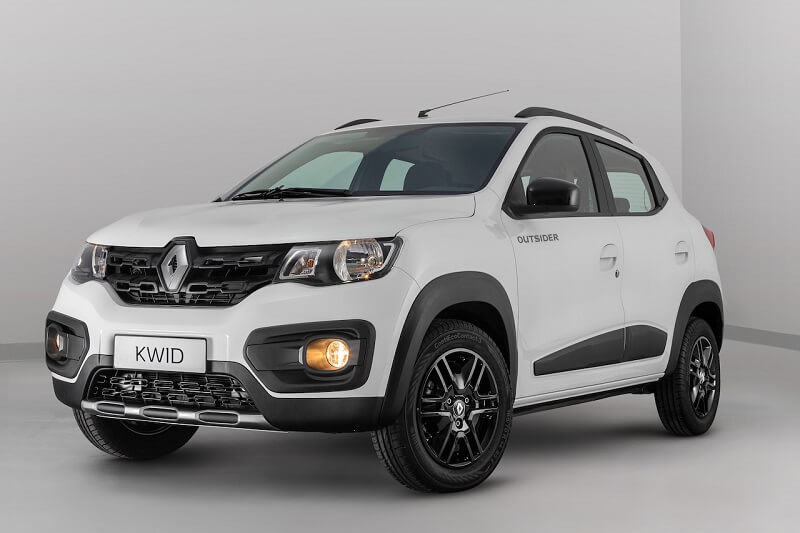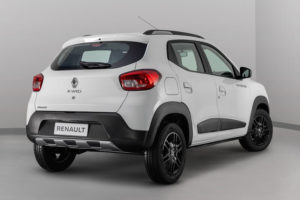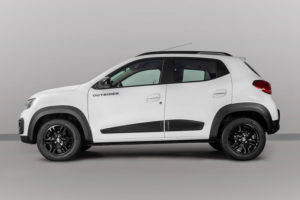The modern and refined Renault Sandero range has become synonymous with a host of features and fitments exclusive to its class. Powered by a Turbo engine (unique in its class), the Sandero boasts a host of superb safety features as well as smart technologies as standard across the range.
When Sandero first entered the South African motoring landscape in February 2009, Renault’s key objective was to provide a high-value proposition in the entry-level passenger car segment.
Initially locally produced in alliance partner Nissan’s Rosslyn plant, the roomy, robust and affordable newcomer was perfectly in tune with customer needs and market trends.
With its introduction of the Sandero range, Renault promised an unparalleled package that would meet the need for affordable motoring and outright value in a tense economic climate.
Sandero through the years: 2009 – 2019
Since its inception in 2009, the Renault Sandero has evolved dramatically with numerous quality, feature and styling enhancements. The introduction of the First Generation top-of-the-range Sandero Stepway in 2011 blazed a red-hot trail popularising the crossover concept in South Africa.
With its comprehensive and fresh line-up, Sandero has continued to enjoy ever-increasing success recording sales of over 58,000 units to date, a notable achievement considering the aggressive competition within AB Entry Hatch, with the likes of Polo Vivo, Ford Figo, Toyota Etios, Suzuki Ignis, Hyundai Grand i10, a segment which represents the lion’s share of the PC market (YTD being 27%).
The flagship Stepway model has proven to be an extremely popular choice with sales in excess of 26,000 cars since its introduction in 2011.
In celebration of its marked success, Renault South Africa is proud to introduce the new enhanced Sandero Stepway Plus, set to replace the current flagship model. It promises delivery against the ever-popular Stepway genetics PLUS more. Hence the model name: new Renault Sandero Stepway plus.
With this introduction the Sandero range maintains the same construct, Sandero Expression remains the entry-level model, followed by an accessible mid-level Stepway Expression derivative, with the New Stepway Plus leading the line-up as the flagship model. All are powered by Renault’s F1-inspired petrol Turbo 66kW engine.
The Renault Sandero range has upheld its aspirational appeal through its key attributes:
Popular by design Renault Sandero’s fresh design and status-enhancing styling, inside and out, have been known to give it a quality and contemporary look and feel.
Striking exterior:
The Sandero proudly hails the brand’s iconic lighting signature seen on all of Renault’s latest models: headlamps that incorporate the characteristic C-shape Daytime Running Lights (LED) plus C-shape rear lights and both the front and rear bumpers have a new design.
Stepway’s crossover styling remains contemporary and refined with features and fitments that include an integrated roof spoiler, higher ground clearance than the entry Sandero Expression, roof bars, front and rear skid plates, wheel arch mouldings and front fog lights.
The range’s assertive stance is underscored by the fitment of 15” wheels (Sandero Expression) and 16” dark metal flex wheels (Stepway).
Inspired interior design:
Quality is perceived in the interior’s design, through the refined finishes and materials used. A generously proportioned interior and above-class average floor-to-roof clearance front and back make for comfortable and roomy seating for five occupants plus luggage while best-in-class boot space (292 litres) can be further improved upon thanks to the split rear bench which is standard across the range offering even more versatility.
Best in class safety features, Renault places emphasis on active safety as a means to avoid accidents and this is borne out by the fact that Sandero is the only car in its class to include EBA (coupled with ABS) and ESP (+ ASR) as standard across the range.
The prestigious Global NCAP safety rating recently awarded the Renault Sandero three stars for adult safety and four for children, proudly making it the safest car for children within its class.
The Sandero also offers passive safety features ‘beyond its class’. In addition to the front seat belts with load limiters and ISOFIX fasteners for child and baby seats, Sandero is the only car in its category to offer a three-point safety belt at the central rear seat.
Emergency Brake Assist (EBA) coupled with ABS The Anti-Lock Braking System (ABS) now comes with EBA which kicks in and automatically applies maximum brake pressure when emergency braking conditions are detected.
Maximum pressure is applied from the onset of braking and remains until the ABS trigger threshold is reached. EBA shortens braking distance by up to nine metres at 120 kph.
An interesting fact is that only 60% of drivers brake sufficiently hard for the ABS system to switch on in an emergency situation.
Electronic Stability (Control) Programme (ESP)40% of road deaths are as a result of accidents that involve loss of control over the vehicle. ESP ensures vehicle stability and assists the driver to avoid possible loss of control; detects and reduces the loss of traction (on slippery road surfaces, for example) and reduces engine power and brakes on independent wheels in the event of loss of control.
Hill Start Assist (HSA)HSA is automatically activated (upon complete stop) as soon as an incline of at least 10% is detected. The system is engaged by stepping firmly on the brake and prevents any backward movement for long enough to pull off without needing to use the handbrake. When stepping off the brake, the car will hold for approximately three seconds to allow pull off with no roll-back.
Enhanced onboard experience:
Many of the features and fitments which come standard with the Sandero range are not seen in this vehicle segment. These include:
On-board Navigation and Smartphone Mirroring [With Apple CarPlay and Android Auto compatability][Model dependent]
ECO mode function:
By electronically modifying the engine’s response at the push of a button, enables drivers to automatically optimise fuel consumption and correct energy-wasting driving parameters to achieve greater economy. It adjusts engine operation within acceptable limits and can reduce fuel consumption and CO2 emissions by as much as 12% depending on driving styles and road conditions.
Bluetooth® connectivity enables safe, convenient and hands-free telephony plus music streaming from portable external devices when on the go. This, together with the 2 DIN integrated radio/CD/MP3 with USB port, is all accessed via fingertip controls located behind the steering wheel for optimum ease and convenience.
The navigation system with map mode will guide you to wherever you want to go - an address or place of interest - and keep a log history of your navigation favourites.
The on-board computer also tracks and displays distance covered, average speed, fuel range, average and total fuel consumption.
Super efficient F1-inspired turbo 66KW engine:
Access to highly efficient and technologically advanced engines is no longer the reserve of expensive cars as proven by Renault’s F1-inspired three-cylinder, 900cc petrol Turbo 66kW engine.
This compact new generation Turbo power plant is standard across the Sandero line-up (the only Turbo-powered model in its vehicle segment) and highly efficient thanks to its lightweight 100% aluminium (HPDC) engine block, low inertia turbo, variable valve timing, piloted variable oil pump and lifetime engine chain.
The Sandero also benefits from a host of innovative solutions transferred from Formula 1 including diamond-like carbon coatings (high tech surface treatment for engine components to reduce friction) and high tumble strategy (optimisation of engine internal aerodynamics to allow better combustion).
The 66kW engine, mated with a manual 5-speed gearbox, exudes amazing power, unparalleled responsiveness and driving pleasure thanks to low-end torque.
With a maximum output of 66kW @ 5 250 rpm, the petrol Turbo power plant delivers a peak torque of 135Nm at 2 500 rpm of which 90% is available from 1 650rpm. Going from 0 to 100kph in just 11.1 seconds, top speed is 169kph.
With the Sandero Expression sipping just 5.2 litres/100km, fuel consumption is competitively low. At an equally impressive 5.4 litres/100km, the Stepway is not far behind. Furthermore, at 119g/km (Sandero) and 124g/km (Stepway), CO² emissions are at a very acceptable low.
Introducing new Stepway plus:
New Renault Sandero Stepway Plus offers the appealing DNA of the Sandero model plus so much more - an even more enhanced SUV look and an even more value for money product.
The exterior of the Stepway Plus is distinguished through its bespoke design and badging with 16” two-tone flex wheel covers, Gloss Black door mirrors with a distinctive red line, and features 3 new enticing body colours: Fusion Red, Highland Silver and Café Brown.
New Stepway Plus offers enriched standard features, such side airbags, front and rear power windows, electric side mirrors, leather steering wheel and gear knob and rear park assist. Cruise control and navigation are also standard (unique in this vehicle segment) while leather seats are an option.
This latest model also offers a new bespoke upholstery design, which is totally on-trend.
The comprehensive Renault MediaNav, integrated onboard multimedia system with 7” touchscreen, is an extremely intuitive system offering quick access to all settings. The new Stepway Plus offers Smartphone Mirroring, an extremely beneficial functionality with Apple CarPlay and Android Auto compatibility.
The Stepway Plus also boasts Rear Parking Camera, to facilitate the driver by alleviating blind spots in reverse mode.
The enhanced Stepway Plus offering remains true to the Sandero value-for-money product range.
Parts and pricing:
From the outset, Sandero has rated highly with regard to parts pricing (and servicing costs in particular) since its introduction to the local market.
In October 2009, just eight months after launching, Renault Sandero 1.6 swept the board in the B vehicle segment of Malcolm Kinsey’s annual Parts Pricing Survey, with comparative parts pricing on competitors’ models proven to be between 61% and 188% more costly.
Kinsey’s 2010 Report named Renault Sandero South Africa’s most affordable car. In the highly contested under R120 000 entry-level passenger car category, the Sandero 1.4 Authentique hatchback was pitted against eight competitor models and proven to be well ahead on parts pricing.
In accordance with the 2016 Malcolm Kinsey findings, Renault Sandero continues to take the lead ahead of its peers on servicing parts pricing.
After-sales warranty and service plan:
The Sandero and New Stepway Plus come with Renault’s 5-year / 150 000 km warranty together with a standard 2-year / 30 000 km service plan. Services are at 15 000km intervals.
Sandero parts are very competitively priced and Renault’s Gauteng-based Parts & Distribution ensures that parts availability is running at 95% plus.
Article source: https://www.wheels24.co.za/NewModels/renault-has-a-new-sandero-stepway-plus-20190610


